Non-Point Source Pollution Simulation and Best Management Practices Analysis Based on Control Units in Northern China
Abstract
1. Introduction
2. Materials and Methods
2.1. Study Area
2.2. Control Unit Division Method
2.2.1. Information Required for Control Unit Division
2.2.2. Control Unit Division Principle
2.2.3. Control Unit Division
2.3. SWAT Model
2.3.1. Parameter Calibration Method
2.3.2. Parameters Sensitivity Analysis Result
2.4. Best Management Practices
2.4.1. Best Management Practices Setting
2.4.2. Best Management Practices Costs
3. Results and Discussion
3.1. Control Unit Division Result
3.2. Spatial–Temporal Distribution of TN and TP Loads
3.2.1. Time Distribution Character
3.2.2. Spatial Distribution Characteristics
3.3. BMPs Effect Simulation
3.3.1. Simulation of Reduction Efficiency
3.3.2. Cost benefit analysis of BMPs
4. Conclusions
Author Contributions
Funding
Conflicts of Interest
References
- Zhang, P.P.; Liu, R.M.; Bao, Y.M.; Wang, J.W.; Yu, W.W.; Shen, Z.Y. Uncertainty of SWAT model at different DEM resolutions in a large mountainous watershed. Water Res. 2014, 53, 132–144. [Google Scholar] [CrossRef]
- USEPA. National Management Measures for the Control of Non-point Pollution from Agriculture; United States Environmental Protection Agency, Office of Water: Washington, DC, USA, 2003.
- Arhonditsis, G.; Tsirtsis, G.; Angelidis, M.O.; Karydis, M. Quantification of the effects of nonpoint nutrient sources to coastal marine eutrophication: Applications to a semi-enclosed gulf in the Mediterranean Sea. Ecol. Model. 2000, 129, 209–227. [Google Scholar] [CrossRef]
- Shen, Z.; Liao, Q.; Hong, Q.; Gong, Y. An overview of research on agricultural non-point source pollution modelling in China. Sep. Purif. Tech. 2012, 84, 104–111. [Google Scholar] [CrossRef]
- Wu, L.; Long, T.Y.; Liu, X.; Guo, J.S. Impacts of climate and land-use changes on the migration of non-point source nitrogen and phosphorus during rainfall-runoff in the Jialing River watershed, China. J. Hydrol. 2012, 475, 26–41. [Google Scholar] [CrossRef]
- Huang, J.J.; Lin, X.; Wang, J.; Wang, H. The precipitation driven correlation based mapping method (PCM) for identifying the critical source areas of non-point source pollution. J. Hydrol. 2015, 524, 100–110. [Google Scholar] [CrossRef]
- Liu, R.; Xu, F.; Zhang, P.; Yu, W.; Men, C. Identifying non-point source critical source areas based on multi-factors at a basin scale with SWAT. J. Hydrol. 2016, 533, 379–388. [Google Scholar] [CrossRef]
- Holas, J.; Hrncir, M. Integrated watershed approach in controlling point and non-point source pollution within zelivka drinking water reservoir. Water Sci. Technol. 2002, 45, 293–300. [Google Scholar] [CrossRef] [PubMed]
- Hunter, P.R. Climate change and waterborne and vector-borne disease. J. Appl. Microbiol. 2003, 94, 37–46. [Google Scholar] [CrossRef]
- Deng, F.L.; Jin, T.T.; Ma, L.K.; Lin, T.; Li, Z.M.; Yuan, Y. Dividing method of control units for watershed environmental management in the 13th national five-year plan. Adv. Water Sci. 2016, 27, 909–917. [Google Scholar]
- USEPA. Handbook for Developing Watershed TMDLs; United States Environmental Protection Agency, Office of Wetlands, Oceans & Watersheds: Washington, DC, USA, 2008.
- Wang, J.N.; Wu, W.J.; Jiang, H.Q.; Xu, M.; Xie, Y.C.; Zhao, K.P. Zoning methodology and application to China’s watersheds for water pollution control. Adv. Water Sci. 2013, 24, 3–12. [Google Scholar]
- Sun, W.; Wang, Y.; Wang, G.; Cui, X.; Yu, J.; Zuo, D.; Xu, Z. Physically based distributed hydrological model calibration based on a short period of streamflow data: Case studies in four Chinese basins. Hydrol. Earth Sys. Sci. 2017, 21, 1–20. [Google Scholar] [CrossRef]
- Chiang, L.-C.; Chaubey, I.; Maringanti, C.; Huang, T. Comparing the selection and placement of best management practices in improving water quality using a multiobjective optimization and targeting method. Int. J. Environ. Res. Public Health 2014, 11, 2992–3014. [Google Scholar] [CrossRef] [PubMed]
- Sheshukov, A.Y.; Douglas-Mankin, K.R.; Sinnathamby, S.; Daggupati, P. Pasture BMP effectiveness using an HRU-based subarea approach in SWAT. J. Environ. Manag. 2016, 166, 276–284. [Google Scholar] [CrossRef] [PubMed]
- Santhi, C.; Srinivasan, R.; Arnold, J.G.; Williams, J.R. A modeling approach to evaluate the impacts of water quality management plans implemented in a watershed in Texas. Environ. Model. Softw. 2006, 21, 1141–1157. [Google Scholar] [CrossRef]
- Arabi, M.; Govindaraju, R.S.; Hantush, M.M. A probabilistic approach for analysis of uncertainty in the evaluation of watershed management practices. J. Hydrol. 2007, 333, 459–471. [Google Scholar] [CrossRef]
- Panagopoulos, Y.; Makropoulos, C.; Mimikou, M. Decision support for diffuse pollution management. Environ. Model. Softw. 2012, 30, 57–70. [Google Scholar] [CrossRef]
- Panagopoulos, Y.; Makropoulos, C.; Mimikou, M. Multi-objective optimization for diffuse pollution control at zero cost. Soil Use Manag. 2013, 29, 83–93. [Google Scholar] [CrossRef]
- Arnold, J.G.; Moriasi, D.N.; Gassman, P.W.; Abbaspour, K.C.; White, M.J.; Srinivasan, R.; Santhi, C.; Harmel, R.D.; Van Griensven, A.; Van Liew, M.W.; et al. SWAT: Model use, calibration, and validation. Trans. ASABE 2012, 55, 1491–1508. [Google Scholar] [CrossRef]
- Abbaspour, K.C. SWATCUP Manual Calibration and Uncertainty Programs; Eawag—Swiss Federal Institute of Aquatic Science and Technology: Dübendorf, Switzerland, 2015; pp. 1–100. [Google Scholar]
- Moriasi, D.N.; Arnold, J.G.; Van Liew, M.W.; Bingner, R.L.; Harmel, R.D.; Veith, T.L. Model evaluation guidelines for systematic quantification of accuracy in watershed simulations. Trans. ASABE 2007, 50, 885–900. [Google Scholar] [CrossRef]
- Ferreira, A.R.L.; Sanches Fernandes, L.F.; Cortes, R.M.V.; Pacheco, F.A.L. Assessing anthropogenic impacts on riverine ecosystems using nested partial least squares regression. Sci. Total Environ. 2017, 583, 466–477. [Google Scholar] [CrossRef]
- Santos, R.M.B.; Fernandes, L.F.S.; Cortes, R.M.V.; Pacheco, F.A.L. Development of a hydrologic and water allocation model to assess water availability in the Sabor River Basin (Portugal). IJERPH 2019, 16, 2419. [Google Scholar] [CrossRef] [PubMed]
- Arnold, J.G.; Kiniry, J.R.; Srinivasan, R.; Williams, J.R.; Haney, E.B.; Neitsch, S.L. Soil and Water Assessment Tool Input/Output File Documentation Version 2009; Texas Water Resources Institute: College Station, TX, USA, 2011. [Google Scholar]
- Liu, R.; Zhang, P.; Wang, X.; Chen, Y.; Shen, Z. Assessment of effects of best management practices on agricultural non-point source pollution in Xiangxi River watershed. Agric. Water Manag. 2013, 117, 9–18. [Google Scholar] [CrossRef]
- Neilen, A.D.; Chen, C.R.; Parker, B.M.; Faggotter, S.J.; Burford, M.A. Differences in nitrate and phosphorus export between wooded and grassed riparian zones from farmland to receiving waterways under varying rainfall conditions. Sci. Total Environ. 2017, 598, 188–197. [Google Scholar] [CrossRef] [PubMed]
- Dermisis, D.; Abaci, O.; Papanicolaou, A.N.; Wilson, C.G. Evaluating grassed waterway efficiency in southeastern Iowa using WEPP. Soil Use Manag. 2010, 26, 183–192. [Google Scholar] [CrossRef]
- Wang, Y.; Bian, J.; Lao, W.; Zhao, Y.; Hou, Z.; Sun, X. Assessing the impacts of best management practices on nonpoint source pollution considering cost-effectiveness in the source area of the Liao River, China. Water 2019, 11, 1241. [Google Scholar] [CrossRef]
- Lam, Q.D.; Schmalz, B.; Fohrer, N. The impact of agricultural Best Management Practices on water quality in a North German lowland catchment. Environ. Monit. Assess. 2011, 183, 351–379. [Google Scholar] [CrossRef]
- Panagopoulos, Y.; Makropoulos, C.; Mimikou, M. Reducing surface water pollution through the assessment of the cost-effectiveness of BMPS at different spatial scales. J. Environ. Manag. 2011, 92, 2823–2835. [Google Scholar] [CrossRef]
- Wang, X.Y.; Zhang, Y.F.; Ou, Y.; Duan, S.H. Optimization and economic evaluation on cost-benefit of Best Management Practices in nonpoint source pollution control. Ecol. Environ. Sci. 2009, 18, 540–548. [Google Scholar]
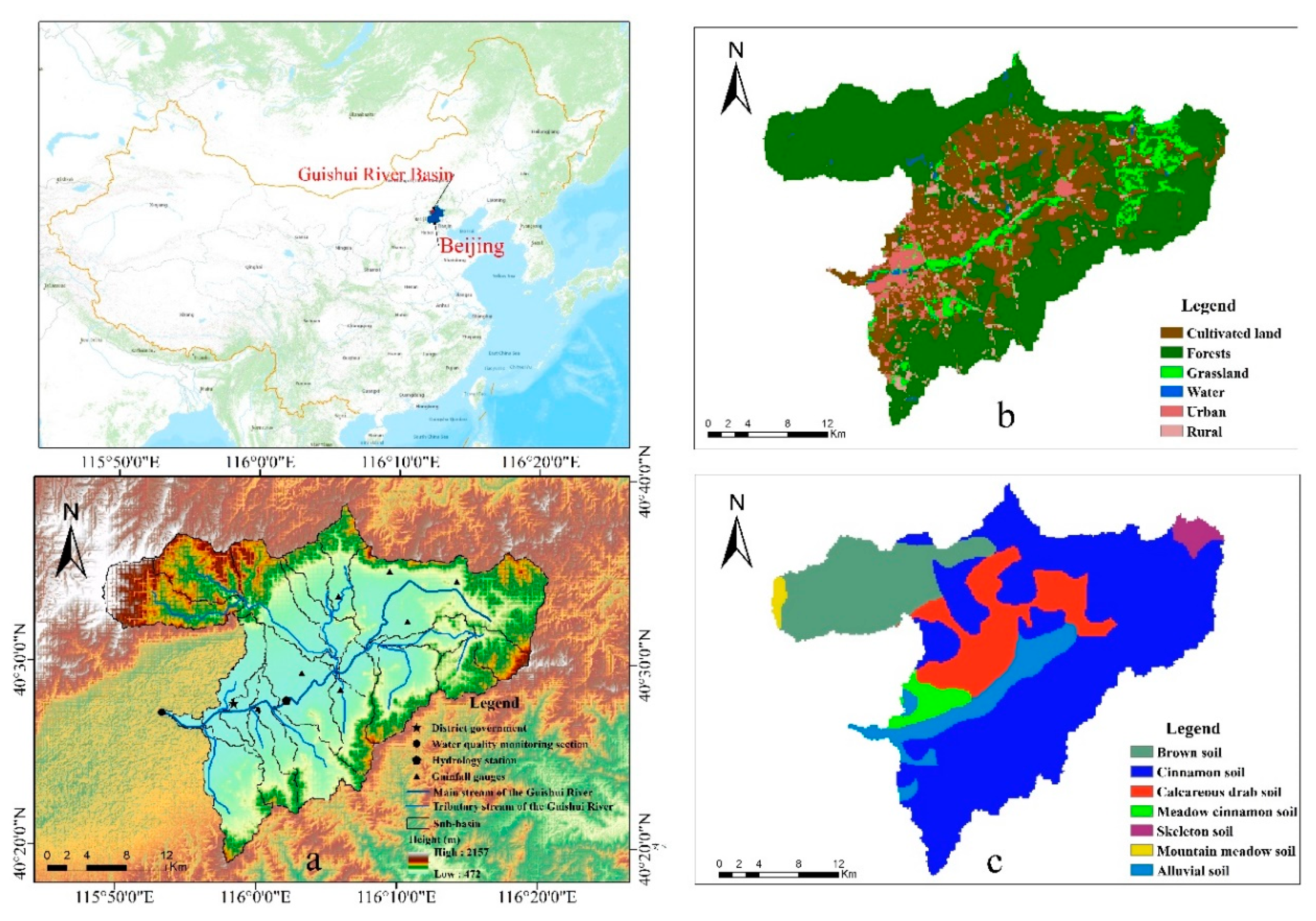
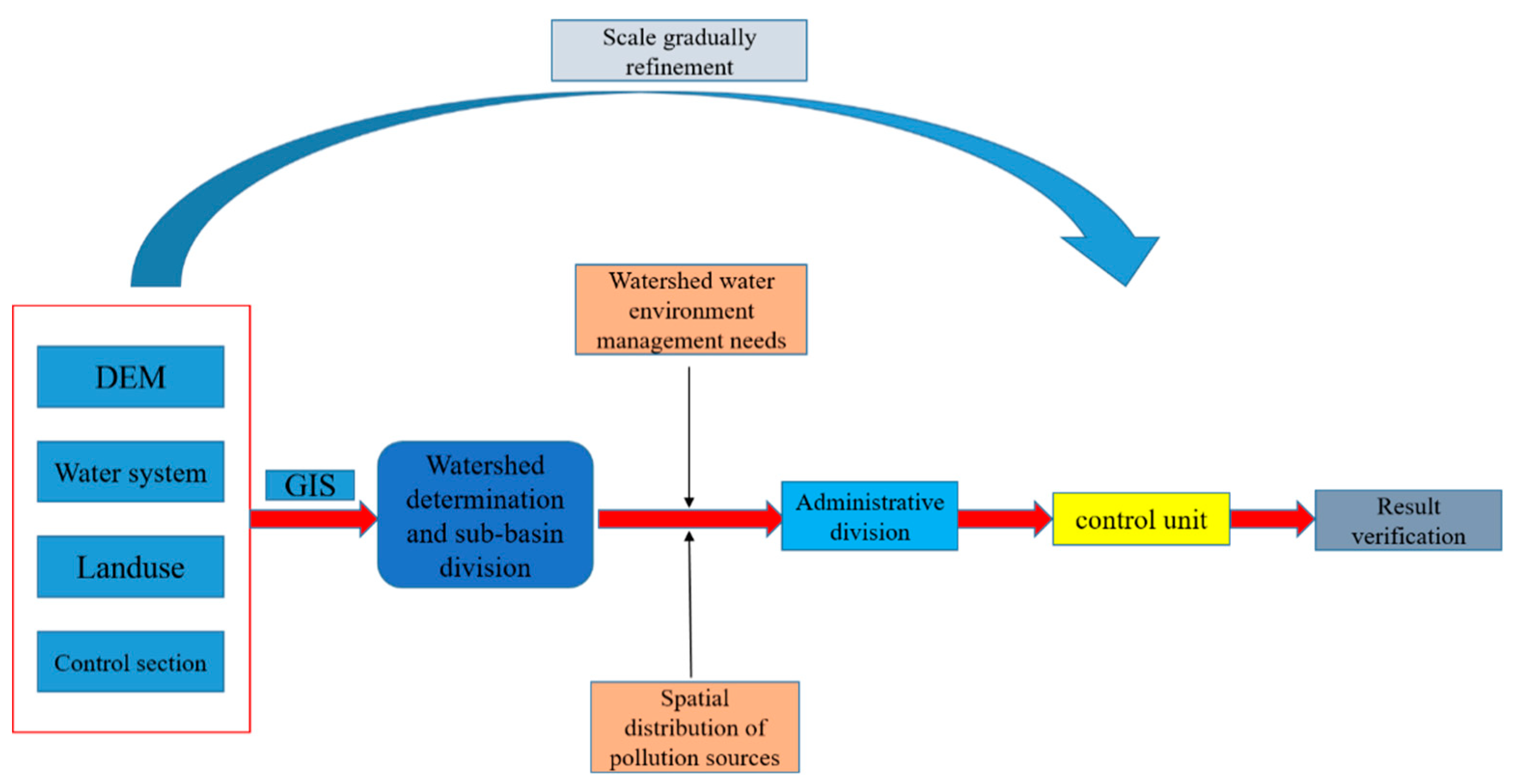
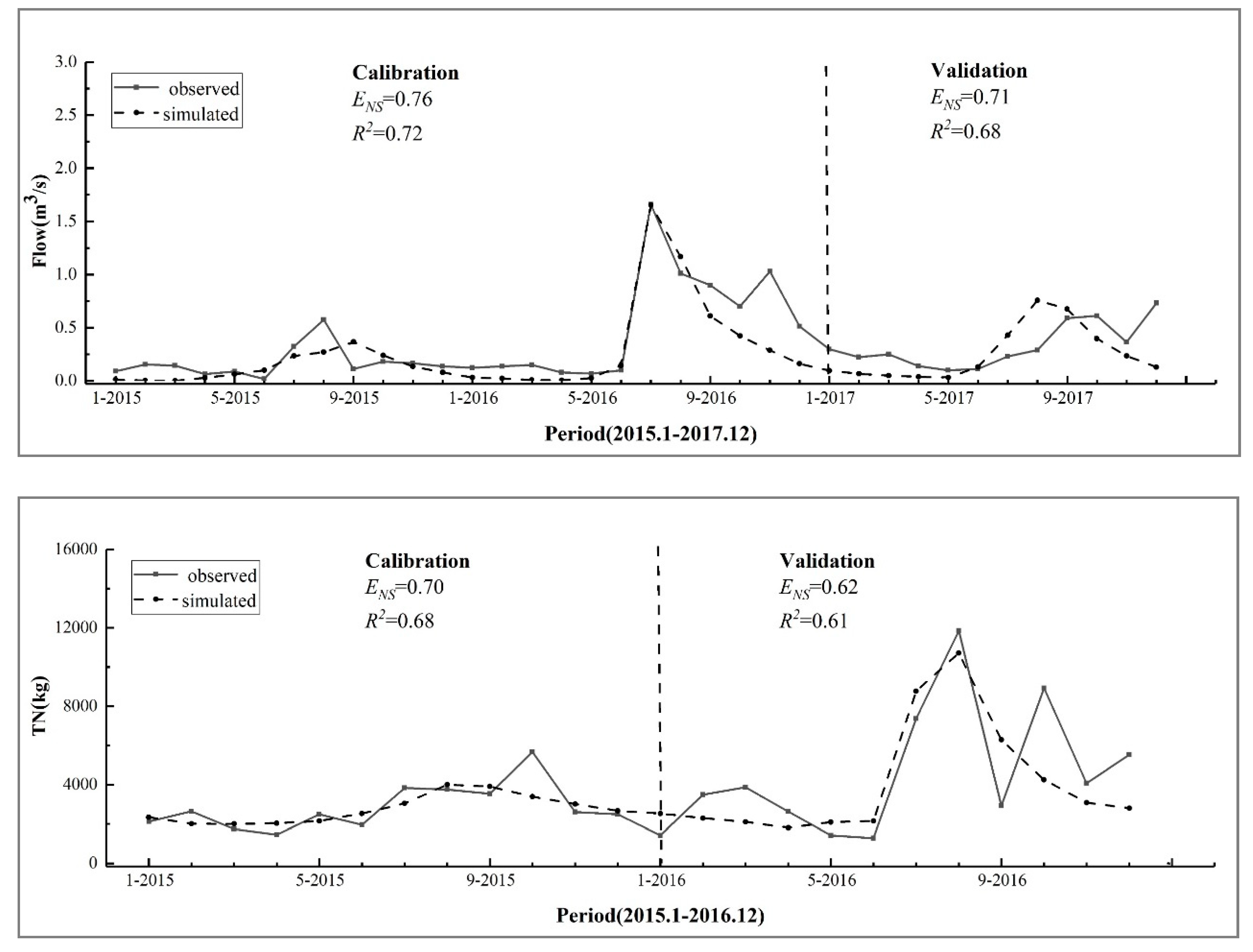
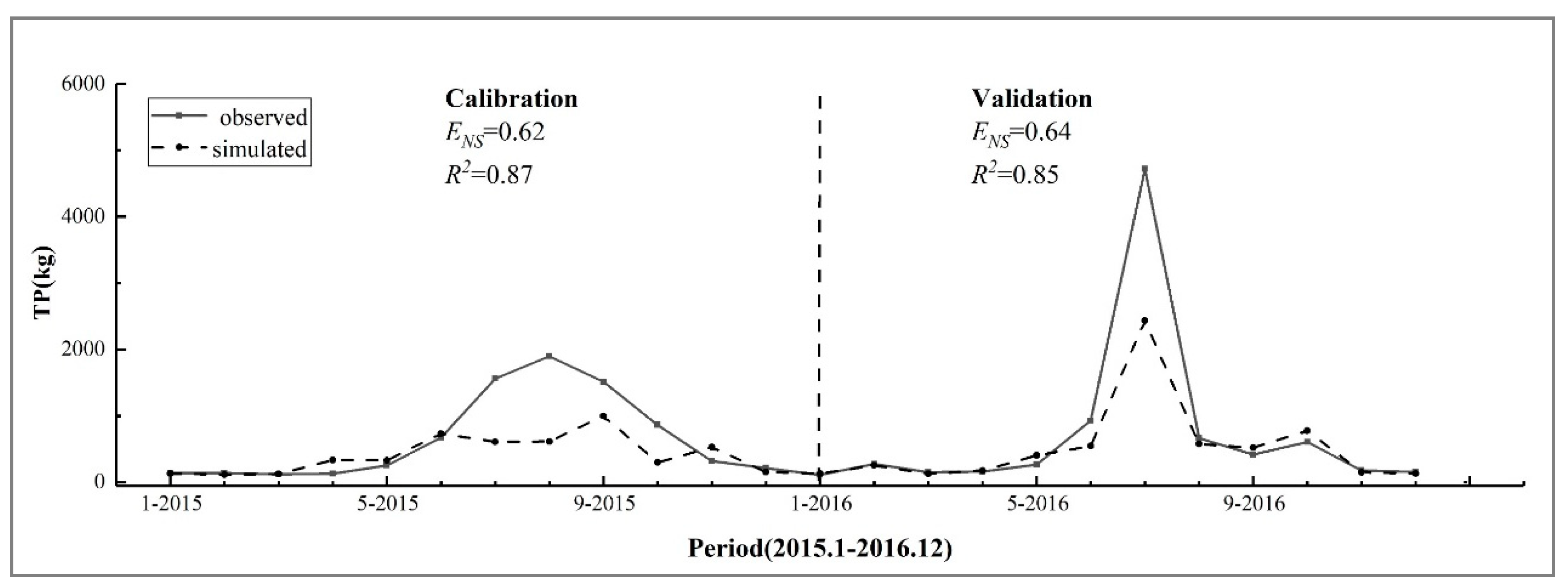
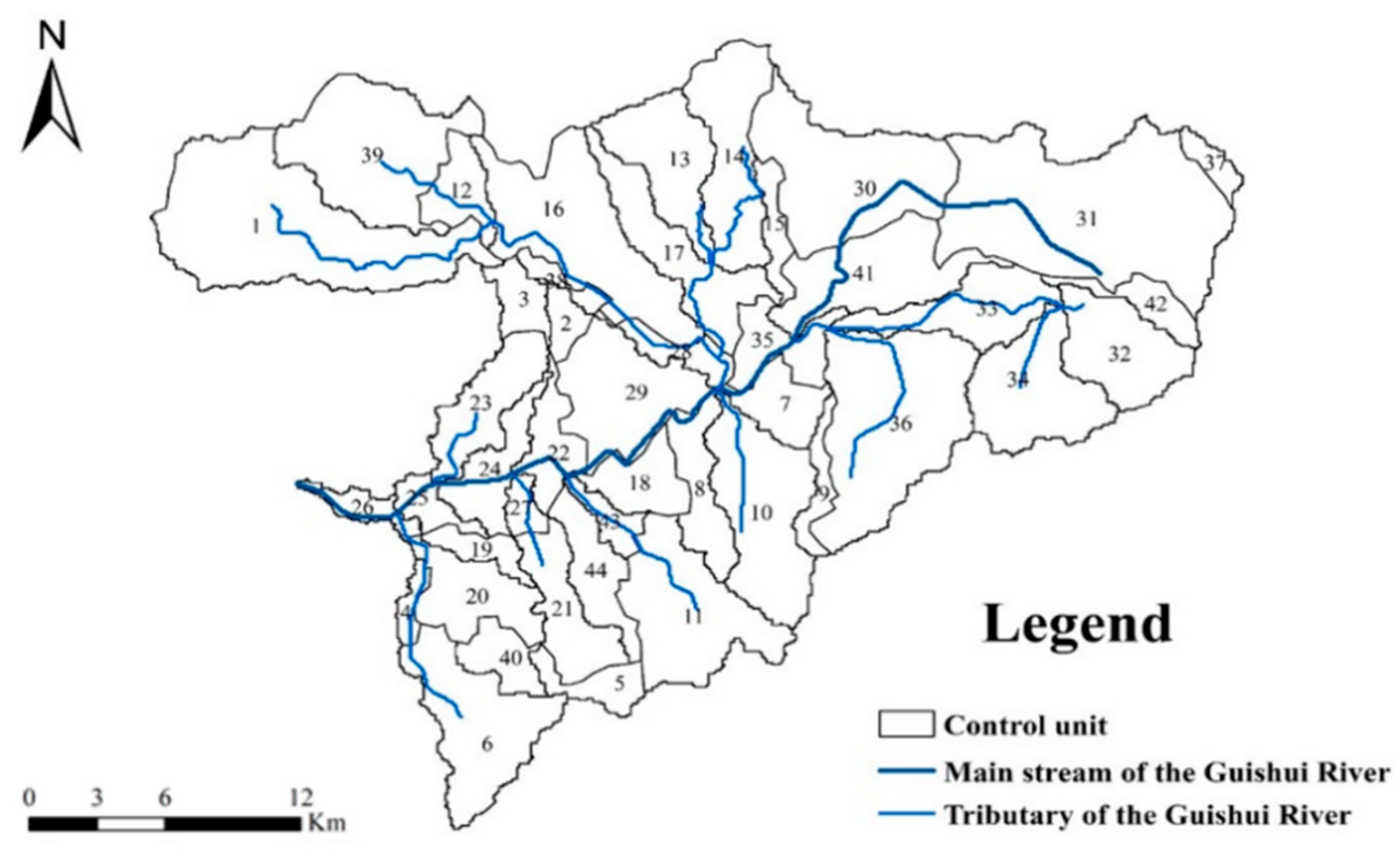
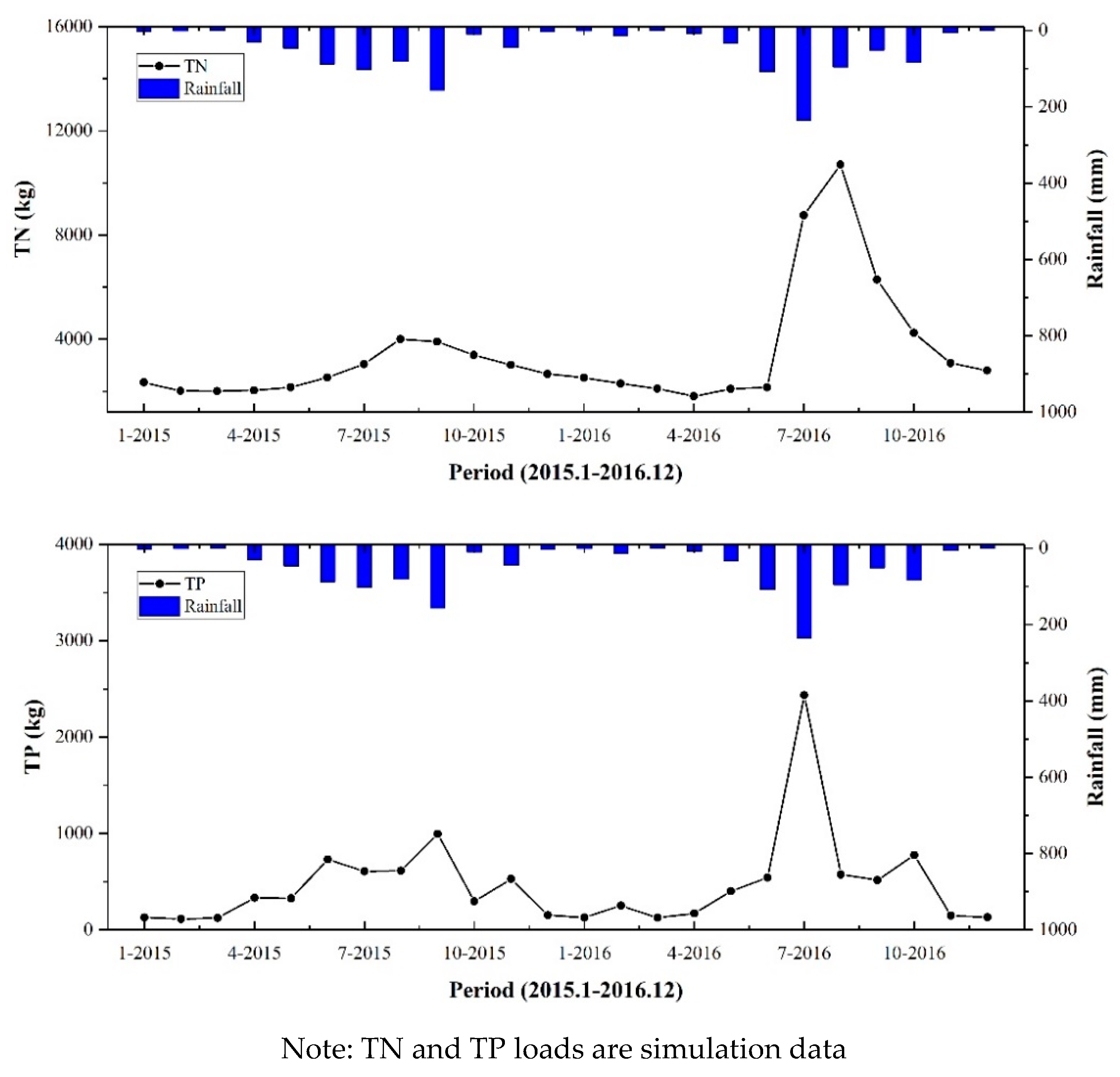
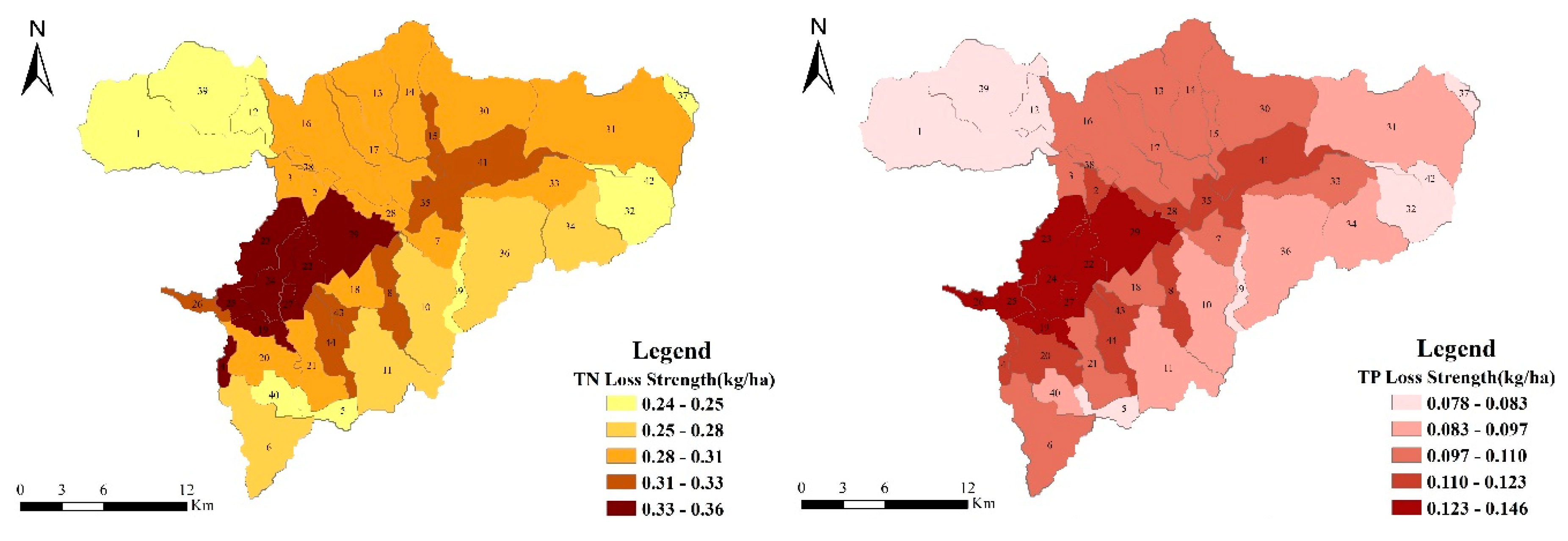
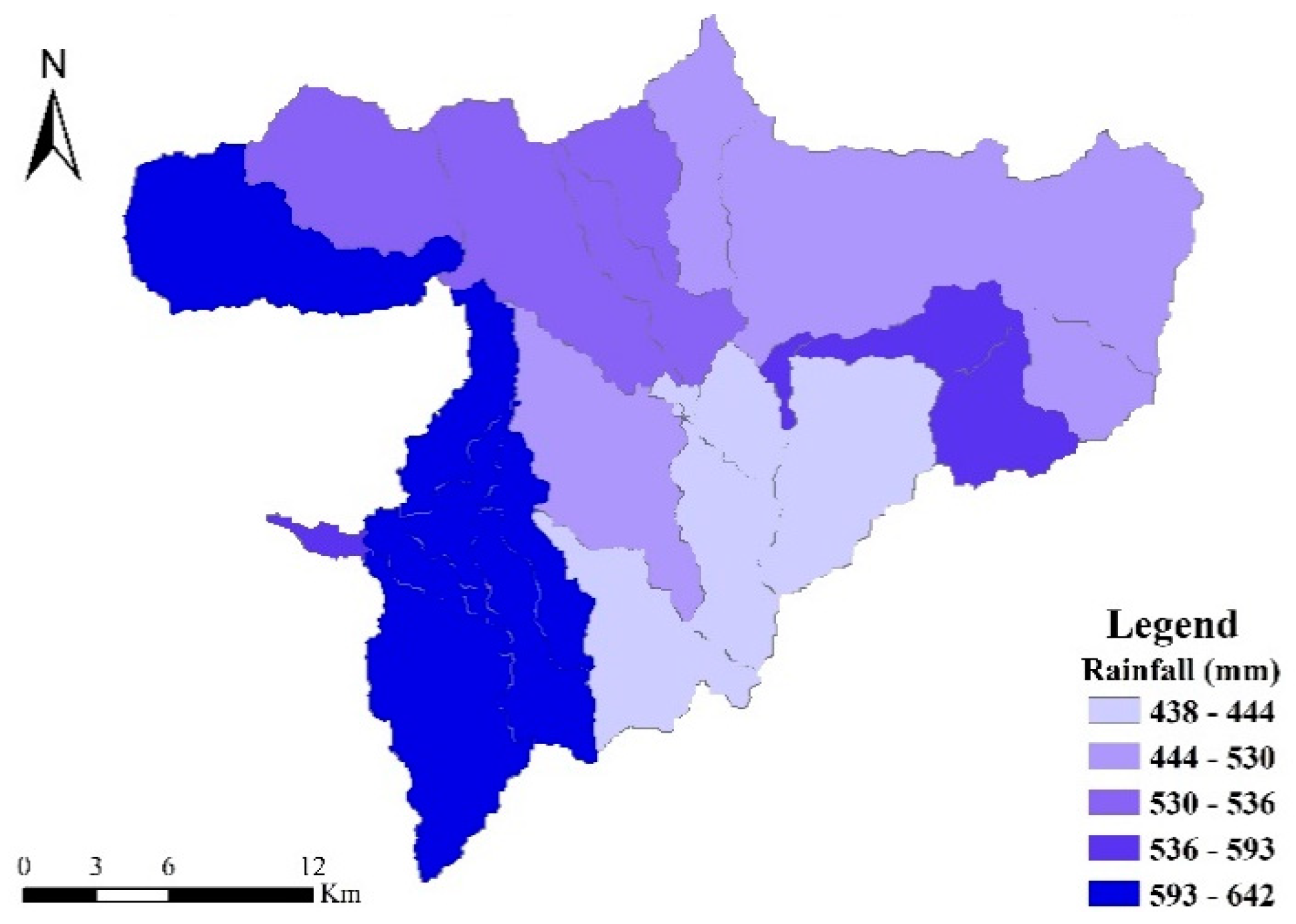
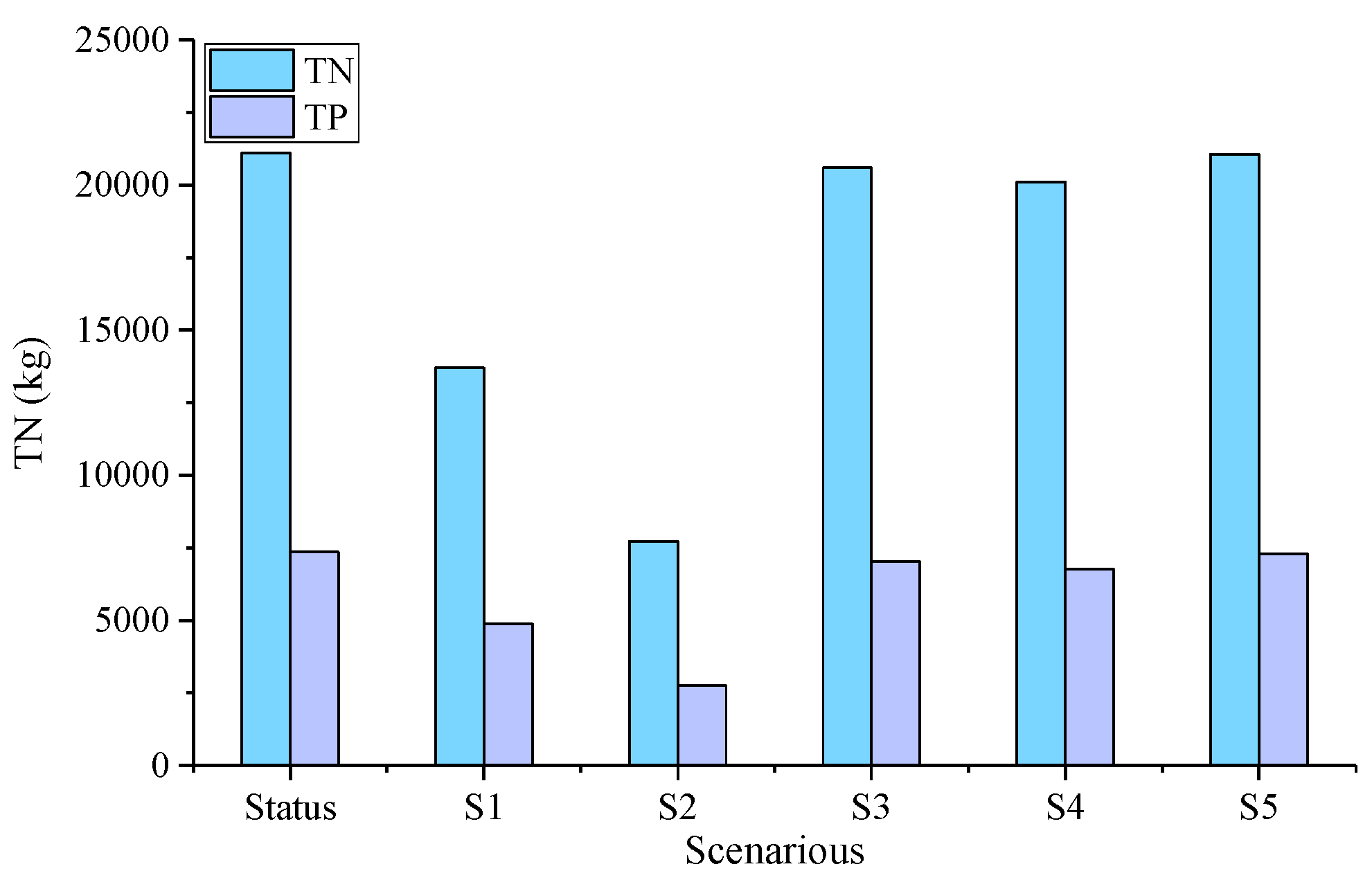
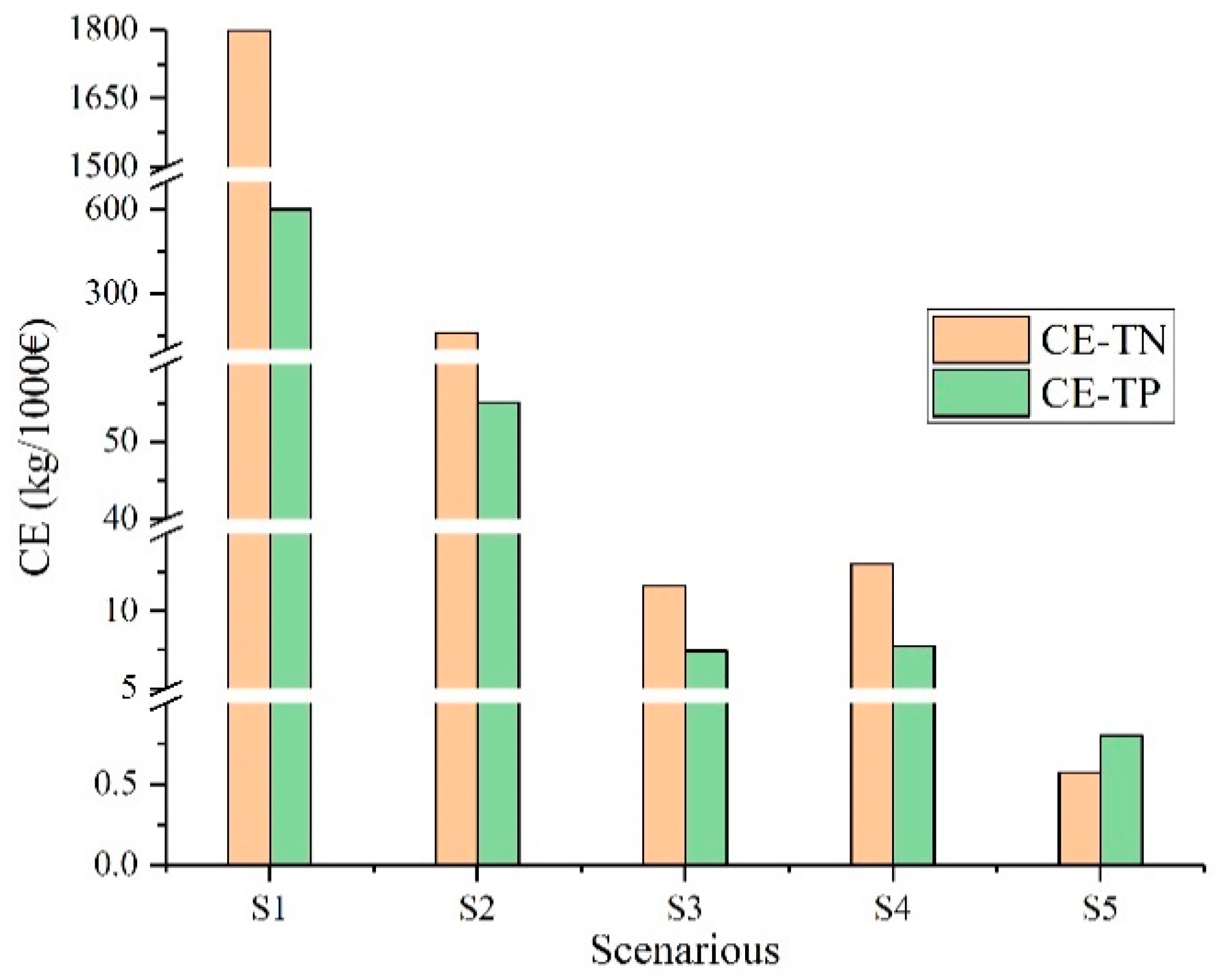
| Type of Data | Resolution/Proportion/Site/Coverage | Period | Format |
|---|---|---|---|
| Digital elevation map | 30 × 30 m | 2017 | GRID |
| Land use | 1:250,000 | 2017 | Arc/Info coverage |
| Soil type | 1:1,000,000 | 2017 | Arc/Info coverage |
| Meteorological data | Yanqing Station | 1959–2017 | txt |
| Rainfall data | Yongning, Xiangying, Liubinbao, Shenjiaying, Jixian, Jingzhuang Station | 2014–2017 | txt |
| Index | Sensitivity | Parameter | t-Star | p-Value | Value | File |
|---|---|---|---|---|---|---|
| Flow | 1 | CANMX | −3.41 | 0 | 0.37 | .hru |
| 2 | CN2 | −3.29 | 0 | 65 | .mgt | |
| 3 | GWQMN | −2.33 | 0.02 | 3686.1 | .gw | |
| 4 | SOL_AWC | 2.24 | 0.03 | 0.56 | .sol | |
| 5 | OV_N | −2.14 | 0.03 | 0.48 | .hru | |
| 6 | SMTMP | −1.21 | 0.23 | −5.98 | .bsn | |
| 7 | SOL_K | −1.11 | 0.27 | 110.8 | .sol | |
| 8 | SMFMN | 0.82 | 0.41 | 9.38 | .bsn | |
| 9 | PLAPS | −0.79 | 0.43 | −409.88 | .sub | |
| 10 | CH_K1 | −0.7 | 0.48 | 474 | .sub | |
| 11 | GW_DELAY | −0.66 | 0.51 | 132.67 | .gw | |
| 12 | RCHRG_DP | 0.47 | 0.64 | 1.22 | .gw | |
| 13 | TLAPS | −0.37 | 0.71 | −2.09 | .sub | |
| TN | 1 | CDN | 3.74 | 0 | 0.09 | .bsn |
| 2 | SOL_NO3 | −3.29 | 0 | 41.94 | .chm | |
| 3 | SDNCO | −2.19 | 0.03 | 0.54 | .bsn | |
| 4 | N_UPDIS | 1.3 | 0.19 | 82.8 | .bsn | |
| 5 | NPERCP | −0.54 | 0.59 | 0 | .bsn | |
| 6 | ERORGN | 0.24 | 0.81 | 6.08 | .hru | |
| 7 | AI1 | −0.09 | 0.93 | 0.08 | .wwq | |
| 8 | SOL_ORGN | −0.07 | 0.95 | 55.92 | .bsn | |
| TP | 1 | SOL_ORGP | 19.7 | 0 | 88.3 | .chm |
| 2 | P_UPDIS | −10.62 | 0 | 13.9 | .bsn | |
| 3 | PHOSKD | −6.8 | 0 | 146.1 | .bsn | |
| 4 | PPERCO | 2.09 | 0.04 | 16.82 | .bsn | |
| 5 | AI2 | −0.38 | 0.71 | 0.02 | .wwq |
| Scenarios | BMPs | Practices Setting | Parameter Adjustment |
|---|---|---|---|
| S1 | Structural measures | Grassed Waterway | .ops file adjusts parameters in GW |
| S2 | VFS (5m) | .ops file FS width is set to 5 m | |
| S3 | Nonstructural measures | Fertilization reduction (10%) | .mgt file modify the amount of fertilizer |
| S4 | Fertilization reduction (20%) | ||
| S5 | No-tillage | .mgt file to join Tillage |
| ID | Control Unit Name | River | Administrative District | Area (km2) |
|---|---|---|---|---|
| 1 | 1-Gucheng River-Zhangshanying | Gucheng River | Zhangshanying | 54.74 |
| 2 | 2-Guishui River-Zhangshanying | Guishui River | Zhangshanying | 3.97 |
| 3 | 3-Sanli River-Zhangshanying | Sanli River | Zhangshanying | 5.97 |
| 4 | 4-Xibazi River-Kangzhuang | Xibazi River | Kangzhuang | 2.7 |
| 5 | 5-Xiaozhangjiakou River-Badaling | Xiaozhangjiakou River | Badaling | 6.4 |
| 6 | 6-Xibazi River-Badaling | Xibazi River | Badaling | 26.37 |
| 7 | 7-Guishui River-Jingzhuang | Guishui River | Jingzhuang | 9.32 |
| 8 | 8-Guishui River-Jingzhuang | Guishui River | Jingzhuang | 11.72 |
| 9 | 9-Baolinsi River-Jingzhuang | Baolinsi River | Jingzhuang | 4.86 |
| 10 | 10-Xierdao River-Jingzhuang | Xierdao River | Jingzhuang | 28.85 |
| 11 | 11-Xiaozhangjiakou River-Jingzhuang | Xiaozhangjiakou River | Jingzhuang | 28.72 |
| 12 | 12-Wulipo River-Jiuxian | Wulipo River | Jiuxian | 8.55 |
| 13 | 13-Xilongwan River right branch-Jiuxian | Xilongwan River right branch | Jiuxian | 18.49 |
| 14 | 14-Xilongwan River-Jiuxian | Xilongwan River | Jiuxian | 23 |
| 15 | 15-Guishui River-Jiuxian | Guishui River | Jiuxian | 5.2 |
| 16 | 16-Gucheng River-Jiuxian | Gucheng River | Jiuxian | 36.1 |
| 17 | 17-Xilongwan River-Jiuxian | Xilongwan River | Jiuxian | 19.67 |
| 18 | 18-Guishui River-Dayushu | Guishui River | Dayushu | 9.93 |
| 19 | 19-Guishui River-Dayushu | Guishui River | Dayushu | 4.99 |
| 20 | 20-Xibazi River-Dayushu | Xibazi River | Dayushu | 14.99 |
| 21 | 21-Xiaozhangjiakou River-Dayushu | Xiaozhangjiakou River | Dayushu | 14.3 |
| 22 | 22-Guishui River-Yanqing | Guishui River | Yanqing | 9.17 |
| 23 | 23-Sanli River-Yanqing | Sanli River | Yanqing | 14.72 |
| 24 | 24-Guishui River-Yanqing | Guishui River | Yanqing | 10.97 |
| 25 | 25-Guishui River-Yanqing | Guishui River | Yanqing | 4.84 |
| 26 | 26-Guishui River-Yanqing | Guishui River | Yanqing | 4.44 |
| 27 | 27-Xiaozhangjiakou River-Yanqing | Xiaozhangjiakou River | Yanqing | 3.28 |
| 28 | 28-Gucheng River-Shenjiaying | Gucheng River | Shenjiaying | 5.83 |
| 29 | 29-Guishui River-Shenjiaying | Guishui River | Shenjiaying | 23.74 |
| 30 | 30-Guishui River-Xiangying | Guishui River | Xiangying | 36.16 |
| 31 | 31-Guishui River-Liubinpu | Guishui River | Liubinpu | 65.34 |
| 32 | 32-Zhoujiafen River-Yongning | Zhoujiafen River | Yongning | 18.82 |
| 33 | 33-Sanlidun River-Yongning | Sanlidun River | Yongning | 17.05 |
| 34 | 34-Sanlidun River-Yongning | Sanlidun River | Yongning | 23.15 |
| 35 | 35-Guishui River-Yongning | Guishui River | Yongning | 10.26 |
| 36 | 36-Konghuaying River-Yongning | Konghuaying River | Yongning | 43.76 |
| 37 | 37-Guishui River-Sihai | Guishui River | Sihai | 3.41 |
| 38 | 38-Gucheng River-Zhangshanying | Gucheng River | Zhangshanying | 3.11 |
| 39 | 39-Wulipu River-Zhangshanying | Wulipu River | Zhangshanying | 34.14 |
| 40 | 40-Xibazi River-Badaling | Xibazi River | Badaling | 7.26 |
| 41 | 41-Guishui River-Yongning | Guishui River | Yongning | 24.09 |
| 42 | 42-Guishui River-Yongning | Guishui River | Yongning | 6.55 |
| 43 | 43-Xierdao River-Dayushu | Xierdao River | Dayushu | 4.39 |
| 44 | 44-Guishui River-Dayushu | Guishui River | Dayushu | 11.29 |
| Scenarios | Reduction Efficient % | Average Reduction Efficiency % | Reduction Amount (kg) | |||
|---|---|---|---|---|---|---|
| TN | TP | TN | TP | TN | TP | |
| S1 | 13.2–46.3 | 15.6–49.6 | 35.1 | 33.7 | 7408.3 | 2478.42 |
| S2 | 33.6–76.6 | 43.6–74.2 | 63.4 | 62.6 | 13,381.38 | 4603.82 |
| S3 | 0.3–4.1 | 0.7–12.9 | 2.4 | 4.4 | 506.55 | 323.59 |
| S4 | 0.5–8.2 | 1–19.4 | 4.7 | 8 | 992 | 588.35 |
| S5 | 0–0.9 | 0.2–6.5 | 0.2 | 0.8 | 42.21 | 58.83 |
| Scenarios | Unit Costs (€/ha) | Implementation Area (ha) | Total Costs (1000 €) |
|---|---|---|---|
| S1 | 206 | 20 | 4.12 |
| S2 | 615 | 136 | 83.655 |
| S3 | 8 | 5441 | 43.528 |
| S4 | 14 | 5441 | 76.174 |
| S5 | 13.5 | 5441 | 73.454 |
| Total | / | / | 280.931 |
© 2020 by the authors. Licensee MDPI, Basel, Switzerland. This article is an open access article distributed under the terms and conditions of the Creative Commons Attribution (CC BY) license (http://creativecommons.org/licenses/by/4.0/).
Share and Cite
Ding, Y.; Dong, F.; Zhao, J.; Peng, W.; Chen, Q.; Ma, B. Non-Point Source Pollution Simulation and Best Management Practices Analysis Based on Control Units in Northern China. Int. J. Environ. Res. Public Health 2020, 17, 868. https://doi.org/10.3390/ijerph17030868
Ding Y, Dong F, Zhao J, Peng W, Chen Q, Ma B. Non-Point Source Pollution Simulation and Best Management Practices Analysis Based on Control Units in Northern China. International Journal of Environmental Research and Public Health. 2020; 17(3):868. https://doi.org/10.3390/ijerph17030868
Chicago/Turabian StyleDing, Yang, Fei Dong, Jinyong Zhao, Wenqi Peng, Quchang Chen, and Bing Ma. 2020. "Non-Point Source Pollution Simulation and Best Management Practices Analysis Based on Control Units in Northern China" International Journal of Environmental Research and Public Health 17, no. 3: 868. https://doi.org/10.3390/ijerph17030868
APA StyleDing, Y., Dong, F., Zhao, J., Peng, W., Chen, Q., & Ma, B. (2020). Non-Point Source Pollution Simulation and Best Management Practices Analysis Based on Control Units in Northern China. International Journal of Environmental Research and Public Health, 17(3), 868. https://doi.org/10.3390/ijerph17030868





